|


By Heather O. Milke
For a week in March, the world watched as the crew of the shuttle Columbia made critical upgrades to the Hubble Space Telescope. Six GW alumni played integral roles in that work. Here we provide a behind-the-scenes look at their mission preparation.
|
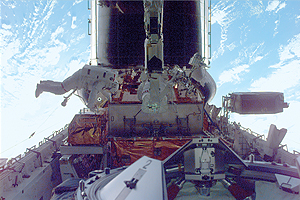
Photos: NASA
|
Dubbed the latest crown jewel of the NASA program, the Hubble telescope has been making history for the past 10 years, quietly churning out never-seen-before images of the universe from an unobscured orbit beyond Earth’s cloudy atmosphere. Ancient galaxies, black holes, comet collisions, and more have all been discovered for the first time with Hubble. It’s virtually impossible to find any space exploration report that doesn’t mention it.
Hubble got off to a slow start in 1990, when, after its highly anticipated launch, it powered up to show the world blurred images of space through a flawed optical system. Luckily, Hubble is a modular system and was repaired in space in December 1993. It then made good on its promises to propel space exploration into the next millennium.
A little more than half-way through its planned useful life of 20 years, Hubble is kept on track with the guidance of complex teams of engineers that help to plan these in-space upgrades.
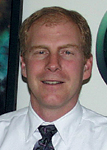 |
|
Ray Lundquist |
That’s where our GW alumni come in. Young, yet already accomplished experts in their field, all six completed an on-site master’s degree program in mechanical engineering that GW conducts at NASA’s Goddard Space Center in Greenbelt, Md. They are now part of the engineering team that prepares, plans, and pulls out all the stops to ensure that Hubble servicing missions go off without a hitch.
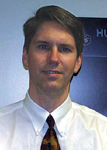 |
|
Steve Leete |
GW Magazine caught up with them as they were preparing for NASA’s fourth Hubble servicing mission, named SM3B. It is a follow-on to the SM3A mission that occurred in late 1999. The work of both missions was to have been accomplished in one trip. However, an unexpected failure of a gyro, which helps to stabilize Hubble’s position in space, required they be split in two, to accommodate an emergency repair.
The previous mission, SM3A, went up on Dec. 19, 1999, and alumni Tim Cole, Steve Hoyle, Cliff Lanham, Steve Leete, and Ray Lundquist all spent their Christmas that year at Johnson Space Center’s mission control in Houston, while alumna Heather Hayden was at the Space Telecope Operations Control Center in Greenbelt, Md.
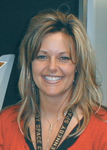 |
|
Heather Hayden |
“I don’t know anyone’s family who dealt with that very well,” says Tim Cole, MS ’01. “Normally, when the launch goes off, everybody cheers. This time, though, everyone was just dead silent. We had been delayed since October for anything and everything. It just got to the point that it was so close to Christmas people were quietly hoping more things would go wrong to prevent the launch.”
When the shuttle is in space, the astronauts aren’t the only ones working. Since these GW engineers have helped to train the flight crew, during the space flight they need to be at the consoles, monitoring the crew’s every move.
On the 1999 mission, for example, Cole, a senior mechanical engineer with Swales Aerospace, provided computer-aided design support, performing real-time analyses of the situation in space as it unfolded. “If they end up going into a different configuration than what we had planned, we have to model it every step of the way and come up with their measurements and clearances—basically try to figure out if everything is going to be okay.”
The work was especially important for that mission, as it had been rushed to make the gyro fix, had then experienced some delays, and was occurring over Y2K.
|
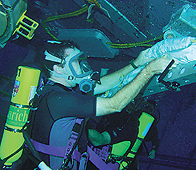
Tim Cole
|
Helping to thoroughly train the astronauts also is vital. At Johnson’s Neutral Buoyancy Lab, astronauts don their bulky space suits and practice handling tools and flight hardware in a giant training pool that aids in simulating the weightless environment of space. Many of the Goddard engineers obtained scuba diving certifications so they could assist in the under-water training of the space crew in learning how to work with the telescope’s hardware.
When they’re not in the pool, the engineers are usually back at Goddard working on hardware development and mission preparation. Their work makes up about a third of the entire Hubble project, with the other two thirds consisting of the daily operations and the science research.
Often traveling from Maryland to Houston and to the Kennedy Space Center at Cape Canaveral, Fla., they all struggle to manage time with their young families while keeping up with mission work. The past few years have been a challenge. This year’s servicing mission is the fourth Hubble mission in five years.
This most recent mission is a major one for several reasons. It is the first shuttle mission in more than two years that will not involve a trip to the international space station. The spacecraft for the mission is the original orbiter, the Columbia, in its first return-to-service mission following a major overhaul last year. Upgrades include an all-new glass cockpit that replaces 1980s analog flight instruments. And, the level of sophistication of the astronauts’ work surpasses the complicated work of most previous missions.
Five major pieces of equipment will fly up with the Columbia to help keep Hubble running smooth for the next eight years.
Scientists are eager for the installation of a new camera, the Advanced Camera for Surveys, which is 10 times more powerful than the current Wide Field/Planetary Camera 2. Once powered up, it will be like having a brand new Hubble, with the ACS’ larger format, faster speed, and higher resolution. The ACS will move astronomers volumes ahead in writing the history of the nature and distribution of galaxies and how our universe evolved.
|
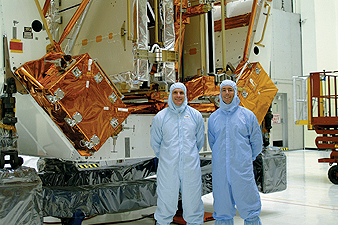
Cliff Lanham and Steve Hoyle with some of the mission equipment at the Kennedy Space Center in Florida.
|
The telescope also will receive a new set of solar wings, when the crew replaces the existing flexible solar array panels with new-technology rigid panels. The old arrays, which have degreaded from exposure to space, are “just basically big window shades, and they’re twisted right now and the danger is that if they twist too much they’ll collapse,” Cole says.
The new panels are 45 percent smaller and produce 25 percent more power than the current arrays. While the old solar arrays were flexible and would roll up like window shades, the new rigid arrays are less susceptible to damage and the extreme temperature variations. They will provide enough extra power to run the new generation of scientific instruments being installed during the mission.
A third plan is to give Hubble a new power control unit. Like the ACS installation, the PCU replacement is attracting a certain amount of attention. Replacing the 11-year-old PCU requires that the Hubble be completely powered down for the first time since its launch in 1990. The new PCU will allow Hubble operators to draw greater amounts of power from the new and more powerful solar arrays.
|
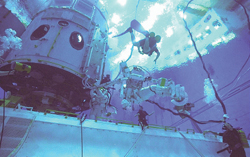
Goddard engineers and other NASA divers help the astronauts train for the mission in the Neutral Bouyancy Lab in Houston.
|
A fourth task is to retrofit an existing instrument that has been dormant on the Hubble for two years. Another camera, the near infrared camera and multiobject spectrometer (NICMOS), was placed on Hubble in 1997 but became dormant in 1999 after depleting all the coolant needed to maintain the low temperatures required by the camera’s infrared detectors. Astronauts will equip the NICMOS with a new experimental cryogenic system that can re-cool the detectors to approximately minus 200 degrees Celsius. This will revive the camera’s infrared vision and extend its life by several years.
A major breakthrough, this new cooling technology likely will find its way into commercial use in personal cameras. The cryo-cooler “runs on very little power and cools to an incredibly low temperature,” explains Ray Lundquist, a lead NASA systems engineer who is part of the project management team for the Hubble. “Colder temperature is better for taking clearer, crisper pictures. The noise that you get from cameras is proportional to the temperature at which you can keep the camera. Most home video cameras run at 30 degrees Celsius, or 300 Kelvin. We’re cooling to one-fifth of that temperature, so you’ll get one-fifth of the noise.”
The last main task, added recently to the mission list, is to replace one of four of Hubble’s reaction wheel assemblies, which help to point the Hubble in various directions. One of them has started to show signs of fatigue, so its replacement was moved forward to this mission instead of Hubble’s fifth servicing mission, scheduled for 2004. The reaction wheels are used to accurately steer and point the Hubble via conservation of anuglar momentum, an engineering term that means to speed up or slow down spinning wheels inorder to change the pointing direction of the spacecraft.
All of these upgrades make challenges for the servicing mission team, Lundquist says.
“One of the hardest parts is that the telescope is in space. Usually when you’re modifying something, you have it in hand. You can check that it works and if it doesn’t work you can shave it, file it, tighten it down a little bit. But right now the telescope is in space. And we’re bringing this stuff up there on the faith that the drawings we have match what it actually is,” he says.
And then there’s the time constraint. “We have a limited amount of time that the astronauts can work in space. Johnson Space Center tells us that’s six hours. Added to that is the time it takes them to suit up, de-suit, and come and go from the shuttle. Then they add a 20 percent adjustment factor is added for the difficulty of operating in space, so on the ground they have to demonstrate that they can do it in five hours. So we have to make the tasks workable enough so that the work can fit in the five days at five hours each. Toward that end, we develop tools, change the interfaces, and try to make them more user friendly and more handleable by the astronauts,” says Lundquist.
During those space walks, Lundquist and the team will all be glued to their stations at mission control.
“We have an enormous support network there in case the astronauts have questions. And we’re hanging on every word they say. As they’re doing their work they’re going through a checklist that they practiced at least 10 times at the Neutral Bouyoancy Lab. If something doesn’t work, I’ve got all my mechanical folks and all my team looking at what’s the appropriate response if that bolt doesn’t turn.
One of those mechanical folks is Heather Hayden, MS ’97, a senior mechanical engineer with Lockheed Martin. She is part of the mechanical systems group that oversees design, testing, and tracking of Hubble’s hardware components. Her job gets as detailed as monitoring how many times an astronaut may be able to turn one bolt on one piece of equipment.
Hayden compiles large documents with all the various load tolerances of all the hardware. That way, they know what to expect if, for instance, “the Hubble hardware were to land and take a severe jolt.” All this information is fed directly to Johnson.
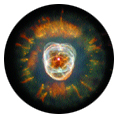
In January 2000, the Hubble, with its Wide Field Planetary Camera 2, captured this planetary nebula, the glowing remains of a dying, Sun-like star. Nicknamed the “Eskimo” Nebula, it is about 5,000 light-years from Earth in the constellation Gemini. Its glowing gases produce the colors in this image: nitrogen (red), hydrogen (green), oxygen (blue), and helium (violet).
|
During mission time, Hayden works at the mechanical systems console. She loves the learning experiences of the job, she says. “The Hubble is one of the neatest pieces of work that my generation will get to see. There’s so many working parts and so much to learn. And the most comforting thing is that no matter what, we all come together as engineers and solve any problems that arise. Like during the last mission, we had some trouble with some hardware. There was a point when everyone’s guts were wrenching. All eyes are on you and you have to make the right decision. Luckily, we’ve always had the right answer.”
Hayden continues to further her GW studies. Studying propulsion technology, she is now working toward a doctor of science degree.
When it comes time to train for the missions, it’s the engineers who are the teachers, while the shuttle’s crew members are the students, Tim Cole explains.
“When they get started, we’re basically doing it for them. We do it, and they do it, and then we tell them when they’re doing something wrong. It’s all sign language or writing little notes—like on an Etch-A-Sketch in the water—to say, ‘Hey, you did that wrong,’” Cole says. “Once we’ve been in the water long enough, they’ll know exactly what they’re doing. Then we try to trick them. We’ll say, ‘Are you sure you did that right?’ Or we’ll plant something, maybe on an electrical connector, for example. Last time we were rolling up little pieces of tape and sticking them in the connectors to make sure they look because they’re supposed to check for orbital debris.”
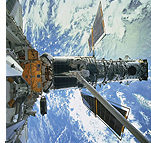 All this makes for good relationships among the engineers and the crew members, who depend on the engineers’ quality training. “They ask us to mess with their minds,” Cole explains. “For example, if they’re not holding on to something—in the water they may be fine, but in space they might start drifting off, so we’ll sneak up behind them and start pushing them off to the side to see if they catch themselves. And that’s a big part of it. If they’re kicking something or flailing around out there in these big huge suits, they may not realize that they’re hitting something. We have to tell them, ‘Hey, you’re doing damage back there.’” All this makes for good relationships among the engineers and the crew members, who depend on the engineers’ quality training. “They ask us to mess with their minds,” Cole explains. “For example, if they’re not holding on to something—in the water they may be fine, but in space they might start drifting off, so we’ll sneak up behind them and start pushing them off to the side to see if they catch themselves. And that’s a big part of it. If they’re kicking something or flailing around out there in these big huge suits, they may not realize that they’re hitting something. We have to tell them, ‘Hey, you’re doing damage back there.’”
Much training goes on outside the pool as well. Steve Leete, MS ’97, a NASA systems engineer with the EVA group, manages part of that work. EVA stands for extravehicular activity, better known as space walks.
The EVA group spends most of its time working directly with the astronauts, which is one of the best parts of the job, he says, because of the crew’s diverse background. For, this mission their professions range from an astrophysicist to a veterinarian.
It’s Leete’s responsibility to make sure the astronauts know everything they possibly need to know about the hardware being used in the mission for the ACS changout. His group provides the crew with all their training tools and aids, including one lead EVA engineer for each of the major equipment changeouts. “Anything the astronauts would ever see or touch is there. And we try to be very responsive to the astronauts. For instance, if they say, ‘Gee, it’d be nice if this handle was over a couple of inches,’ we try to make it happen,” he says.
With the large amount of EVA work occurring on this mission, there was much to prepare for.
“We’ve had to get this crew trained on two different kinds of solar arrays, that all have different interfaces,” Leete says. “We’ve also been challenged by how quickly the work needs to get done. We’ve come up with a number of tools and techniques to try to make the jobs go more quickly.”
Some new tools were made for the power control unit change out. “The trick there has been to protect the telescope while it is completely shut down. Some of the tools are simple, like the old box didn’t have handles on it, so we made snap-on handles they can use to move the unit around easily, but some other things are more complicated.”
For example, there is something called the harness restraint device. “It has elastic loops on it—every time they de-mate one of these 36 connectors, they have to stretch out one of these elastic loops and push the connector into it and let the elastic pull the connector out of the way.”
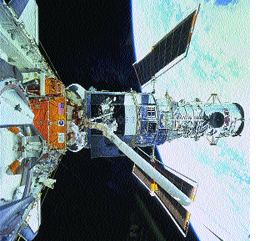 And then there’s the new cooling system, designed of components not envisioned to exist during the original Hubble design. “We have designed that from a blank sheet of paper,” Leete says. “Getting all the EVA interfaces on that to be right has been pretty challenging because we were starting from nowhere.” And then there’s the new cooling system, designed of components not envisioned to exist during the original Hubble design. “We have designed that from a blank sheet of paper,” Leete says. “Getting all the EVA interfaces on that to be right has been pretty challenging because we were starting from nowhere.”
While the astronauts are completing their training, all the hardware that will fly on the shuttle is getting completed and sent to Kennedy Space Center in Florida. Cliff Lanham, MS ’98, is the Kennedy ground operations manager who is there to receive it.
Lanham, as they say, is your man in Florida. “It’s not your typical eight-hour desk job,” he admits.
While most of the legwork prior to a mission takes place at other centers like Goddard, Kennedy starts buzzing just about when Lanham arrives from his home base at Goddard. As a integration and test manager of the payload bay carriers, it’s Lanham’s job to ensure the new telescope hardware arrives in space safely.
He uses this analogy to decribe his work: “If you envision the shuttle as a car, and you envision a baby, you want to make sure your baby gets safely from the house to wherever you’re going. So to me the carriers are like a car seat. You want to make sure the baby is safe and gets a good ride. You can carry all the expensive hardware you want to carry, but if you don’t get it there in good shape, it’s useless.”
An Orbital Sciences Corp. employee, Lanham moves his young family to Florida a few months before launch, and they remaint there until shortly after the shuttle and carriers have returned.
After monitoring the incoming shipments of hardware from Goddard, he then plans the testing and ground handling of the flight ware. All contingency plans need to be considered, he says. “Hurricanes, storms, anything could come up. We try to foresee and have a plan in place for everything.”
All the work comes down to that final moment: the launch. “You want all your hardware to be okay when they open those doors,” he says.
Like Lanham, Steve Hoyle, MS ’93, also temporarily moves his family south. With three kids age 5 and under, Florida’s white sandy beaches are a big selling point for having to be away from their Woodbine, Md., home. The location also goes a little way in making up for some of the homesickness that inevitably occurs, especially during Hoyle’s long hours.
Also an Orbital employee, Hoyle is the manager of the Second Axial Carrier, known as the SAC. So while Lanham is monitoring work for all of the carriers, it’s Hoyle’s job to zero-in on the hardware and development of the SAC. The Advanced Camera for Surveys will be traveling to space on his carrier.
To manage this multimillion dollar equipment transport, Hoyle monitors his carrier, “from cradle to launch and throughout the mission,” he says. He starts with the design of the giant enclosure box, with its super-power shock absorbing system. He then oversees its manufacturing. He also dives with the shuttle crew to assist in training.
The job can be incessantly demanding, but it’s not without its rewards, he says. “I like being able to see the whole project through, from conceptualization to completion. In a lot of jobs, you only have your part, and when you’re finished you hand it off or turn it over. Even after launch, if there’s a problem, it’s like in Apollo 13—we all get to be in the control room to figure out what to do next.”
And in this mission, the variables are much greater. “It’s the most challenging one we’ve done in terms of the equipment we’re sending and the difficulty of the tasks astronauts are doing. The astronauts are looking forward to it, too. It is a desirable mission to be assigned to for an astronaut. They do more EVA than they would get to do on the space station mission.”
All that will make for added excitement in Houston.
During the mission week, “It’s like our Super Bowl,” Tim Cole says. “Everything we’ve been training to do comes down to then.”
Cole remembers his first servicing mission. “I was just sitting there worried about this hundred million dollar instrument. If it didn’t fit, it would be my head.”
But Cole knows what it’s like to be really nervous. He was the only one of these six who was around for Hubble’s 1990 launch.
“It was disastrous at the time,” he says. “Everybody was making jokes on the late-night talk shows. And then there was one of those Police Academy-type movies—it had a wall of famous disasters like the Hindenberg, and the Hubble was the last one.”
Yet he also witnessed the success of the first servicing mission, and how every day of the mission was covered on the front page of The Washington Post. “A lot of people had been saying that NASA was in jeopardy and that we saved more than just the Hubble program.”
All six alumni will be manning their posts at mission control. Most of the shifts are 12 hours, but they really spread to 13 or 14 hours once you get briefed by the shift before you and then you brief the shift coming in after you.
Ray Lundquist’s trip to Houston will be different this time, he says. Unlike previous missions where he was mostly concerned with the specific equipment he worked on, this time, “I’m involved in the entire thing—and I don’t really know how I’m going to react. But I feel confident. I feel like we’ve turned over every stone we could find to look for monsters. And we’ve uncovered quite a few. But yes, I’m going to be nervous—in case there is something we missed.”
After the successful completion of this mission, there’s one more scheduled for 2004. Then, Hubble will be retired in 2010 as NASA begins to make way for the Next Generation Satellite Telescope, the next big observation project coming down the NASA pike.
But the NGST will be out of the space shuttle’s range, and most of these NASA engineers will be reorganized on to other projects. “There isn’t a place on NGST for these people because it is going to an orbit about a million miles from the Earth,” Leete says.
Knowing these facts, Leete, who previously worked on Hughes satellite projects, has been doing a little planning. “I thought we ought to document some of our experiences for spacecraft designers so that if they wanted to design a satellite that could be serviced by astronauts, they’d have a handy tutorial on what to consider. There are a lot of lessons learned from the design of the Hubble itself—what was easy, what was hard, what we would do differently next time.”
Leete wants NASA to have the information it needs to decide whether to build servicing into future big telescopes. “And if so, how? Do we need to get astronauts out to higher orbits than where the shuttle can get to now? Right now, it can only get to orbits where a small number of satellites are located.”
It is still unknown whether NASA will want to invest in these capabilities, Leete says. “These are all big questions as to when and how much we’ll do it and how it relates to exploration to the moon and to Mars.”
Whatever NASA decides, it seems likely that these six alumni will play a starring role.
After five days of repairs, the shuttle Columbia crew released Hubble into orbit on March 9 to resume its science mission. The equipment upgrades were successful, and the Columbia landed safely at Kennedy Space Center on March 12.
Special thanks to Eric Foster, Dave Lychenheim, and Carl Winebarger for providing the photographs for this article.

As Seen from Space
 Glittering stars and wisps of gas create the backdrop for the self-destruction of the massive star supernova 1987A, located in the Large Magellanic Cloud, a nearby galaxy. Astronomers in the Southern Hemisphere witnessed the brilliant explosion of this star in 1987. Shown here is the supernova remnant, surrounded by inner and outer rings of material, set in a forest of ethereal, diffuse clouds of gas. This three-color image comprises several pictures of the supernova and its neighboring region taken with the Wide Field and Planetary Camera 2 in 1994, 1996, and 1997. The many bright blue stars near the supernova are massive stars, each more than six times heftier than the Sun. Glittering stars and wisps of gas create the backdrop for the self-destruction of the massive star supernova 1987A, located in the Large Magellanic Cloud, a nearby galaxy. Astronomers in the Southern Hemisphere witnessed the brilliant explosion of this star in 1987. Shown here is the supernova remnant, surrounded by inner and outer rings of material, set in a forest of ethereal, diffuse clouds of gas. This three-color image comprises several pictures of the supernova and its neighboring region taken with the Wide Field and Planetary Camera 2 in 1994, 1996, and 1997. The many bright blue stars near the supernova are massive stars, each more than six times heftier than the Sun.
 A huge, billowing pair of gas and dust clouds are captured in this stunning Hubble image of the supermassive star Eta Carinae. Using a combination of processing techniques, astronomers created one of the highest resolution images of an extended object ever produced by the Hubble. A sequence of eight exposures was necessary to cover the object’s huge dynamic range. Eta Carinae was the site of a giant outburst about 150 years ago, when it became one of the brightest stars in the southern sky. Though the star released as much visible light as a supernova explosion, it survived the outburst. Somehow, the explosion produced two polar lobes and a large thin equatorial disk, all moving outward at about 1.5 million miles per hour. Estimated to be 100 times more massive than the Sun, Eta Carinae may be one of the most massive stars in our galaxy. It radiates about five million times more power than our Sun. The star remains one of the great mysteries of stellar astronomy, and the Hubble images raise further puzzles. A huge, billowing pair of gas and dust clouds are captured in this stunning Hubble image of the supermassive star Eta Carinae. Using a combination of processing techniques, astronomers created one of the highest resolution images of an extended object ever produced by the Hubble. A sequence of eight exposures was necessary to cover the object’s huge dynamic range. Eta Carinae was the site of a giant outburst about 150 years ago, when it became one of the brightest stars in the southern sky. Though the star released as much visible light as a supernova explosion, it survived the outburst. Somehow, the explosion produced two polar lobes and a large thin equatorial disk, all moving outward at about 1.5 million miles per hour. Estimated to be 100 times more massive than the Sun, Eta Carinae may be one of the most massive stars in our galaxy. It radiates about five million times more power than our Sun. The star remains one of the great mysteries of stellar astronomy, and the Hubble images raise further puzzles.
 This small spiral galaxy, NGC 7742, is what’s called a Seyfert 2 active galaxy, a type of galaxy that is probably powered by a black hole residing in its core. Its core is the large yellow area in the center of the image. The lumpy, thick ring around this core is an area of active starbirth. The ring is about 3,000 light-years from the core. Tightly wound spiral arms also are faintly visible. Surrounding the inner ring is a wispy band of material, which is probably the remains of a once very active stellar breeding ground. This small spiral galaxy, NGC 7742, is what’s called a Seyfert 2 active galaxy, a type of galaxy that is probably powered by a black hole residing in its core. Its core is the large yellow area in the center of the image. The lumpy, thick ring around this core is an area of active starbirth. The ring is about 3,000 light-years from the core. Tightly wound spiral arms also are faintly visible. Surrounding the inner ring is a wispy band of material, which is probably the remains of a once very active stellar breeding ground.
 This composite image, taken in 1996, depicts a brilliant collision between two galaxies. The cores of the twin galaxies are the orange blobs, left and right of image center, crisscrossed by filaments of dark dust. A wide band of chaotic dust, called the overlap region, stretches between the cores of the two galaxies. The sweeping spiral-like patterns, traced by bright blue star clusters, shows the result of a firestorm of star birth activity that was triggered by the collision. This composite image, taken in 1996, depicts a brilliant collision between two galaxies. The cores of the twin galaxies are the orange blobs, left and right of image center, crisscrossed by filaments of dark dust. A wide band of chaotic dust, called the overlap region, stretches between the cores of the two galaxies. The sweeping spiral-like patterns, traced by bright blue star clusters, shows the result of a firestorm of star birth activity that was triggered by the collision.
Back to top | Spring 2002 Table of Contents
|